
Check the active emergency information hub from HSEM.
Check smoke alarms and carbon monoxide detectors
Contact your healthcare provider If you are sick and need medical attention. Wait for further care instructions and shelter in place, if possible. If you are experiencing a medical emergency, call 9-1-1.
Gas up your car and (if you have one) generator. Check for old, bad gas in the generator.
DriveTexas.org shows real time road conditions. Travis County
Road Closures shows planned closures.
For organizers: Austin Real Time Road Conditions is the data on the open porta
To get a forecast from the National Weather Service (English only) in your exact location, go to the page for Austin/San Antonio, and scroll down to this section. Click your exact location on the map and see the detailed forecast change for your area.
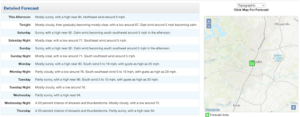
Get supplies ready in case you need to stay home for many days without power. Get extra water, non-perishable food, pet food, and fast-burn logs for cooking outside. If you don’t have one, get an electric heater.
Have extra batteries for radios and flashlights.
Think about each person’s special needs, like medicine.
Don’t forget about your pets. Bring them inside and lock pet doors.
Cover pipes and drip faucets.
Cover windows with bubble wrap for extra insulation.
In addition to buying bottled water, store extra water in bathtub, sink or containers.
Alert vulnerable neighbors and share warming supplies. Think about people who are unhoused, older adults, and people living alone or with physical disabilities.
Stay inside and stay warm if you can. If you have to go outside, bundle up.
Wear layers of loose-fitting, lightweight, warm clothing. Remove layers to avoid overheating, perspiration and subsequent chill.
If doing strenuous outdoor activities, avoid wearing cotton. Once wet, cotton takes a long time to dry and will sap your heat. Use synthetic fabrics that wick moisture from your skin and dry quickly.
Outer garments should be tightly woven, water repellent, and hooded.
Wear a hat, because 40%of your body heat can be lost from your head.
Cover your mouth to protect your lungs from extreme cold.
Mittens, snug at the wrist, are better than gloves.
Try to stay dry and out of the wind.
Limit phone use to conserve power or keep phones charged.
Put perishables outside to keep cold.
Run cord for electric heaters to generators placed outside only.
Use fireplaces safely.
If your power is on, keep energy use low to preserve power.
Check on neighbors who don’t have power.
Children sometimes need to ask questions to feel safe, and will usually ask questions they are ready to hear the answer to. Follow their lead, answering the questions they ask.
Kids may want to help with light tasks.
Reading books and playing games can help kids feel more normal and less scared.
Check the city website if you need shelter. Information on warming centers and shelters can be found on HSEM’s Active Emergency Information Hub page and the city’s shelter page.
Shelter for people who are unhoused can be found on the city webpage for Homeless Resources.
If power is off, do NOT run generators inside the house.
If power is off, do NOT use the oven or stove for heat.
Be careful! Even if the roads look just wet, they might still be slippery. Every year, over 5,000 people die on the roads because of the weather.
Before you start driving, make sure your vehicle is totally free of ice and snow. Snow flying off cars can cause accidents.
Tell someone where you are going and which way you will take. If something happens, they will know where to look for you.
Don’t leave home without these things: a fully charged phone, a car charger, and an emergency kit in your car.
If you start to skid while driving, stay calm, slowly take your foot off the gas, and steer in the direction you want the front of the car to go. If your car has an anti-lock braking system (ABS), press the brake pedal down firmly. Do not pump the brakes if your car has ABS.
If it’s hard to see because of the weather, pull over and stop your car until you can see better. Turn off your lights and use your parking brake when stopped to prevent another car from following your lights and hitting you.
Stay in the vehicle!
If you leave your vehicle, you will become disoriented quickly in wind-driven snow and cold.
Run the motor about 10 minutes each hour for heat.
While running the motor, open the window a little for fresh air to avoid carbon monoxide poisoning.
Clear snow from the exhaust pipe to avoid gas poisoning.
Be visible to rescuers.
Turn on the dome light at night when running the engine.
Tie a bright colored cloth, preferably red, to your antenna or door.
After snow stops falling, raise the hood to indicate you need help
If you have sought shelter, return home only when authorities say it is safe. Avoid driving except in emergencies.
Be aware that your pipes may be broken. To prevent flooding, turn the water off at the street and call for repair.
Advocate early if you are running low on water.
In some cases, the city or county will set up resource and recovery centers, or activate resilience hubs to help people connect to supplies and resources.
Get insurance estimates early. If you don’t have insurance, check the city website for repair programs.
Check the city website if you need shelter.
Apply online for FEMA as soon as possible. If you need assistance, look to see if a disaster recovery center is set up near you.
Check the city website if you need shelter.
Have a go-to network of neighbors and friends you can stay with.
Know where your nearest warming centers, shelters and resilience hubs are located.
Learn about hypothermia and other weather risks. See below for more information.
Sign up for alerts through CTOSH, Warn Central Texas, and if needed, the Unhoused Alert System.
[add links]
Avoid underpasses, underground parking garages and basements.
Avoid hiking or camping if thunderstorms are predicted.
Trim trees near power lines or old, dead limbs. Trees on your property that could fall on lines between the pole and your house are your responsibility.
Make an emergency kit. (See the preparation page).
Install check smoke alarms and carbon monoxide detectors that have battery backups.
If you can’t pay for your heating, fixing your home to keep heat in, or other energy-related repairs, ask the Low Income Home Energy Assistance Program (LIHEAP) for help.
Buy a generator and battery-powered chargers for phones and other important equipment.
Know where your nearest warming centers, shelters and resilience hubs are located.
Make sure you have a kit ready with things kids need like diapers, baby food, and toys. Talk to your kids about what to do in winter storm so they’re not scared.
Sign up for local emergency help for older people. This help can include special support if you need to leave your home quickly. Keep your medicines and supplies where you can get them easily. Connect to a friend. Consider staying at someone else’s house.
Make sure your mobility tools are ready and working. Try to have someone you can call for help in an emergency. Consider staying with a friend.
Keep your pregnancy care items and medicines in your emergency kit. Be sure to have extra clean water on hand. Stay near clean water and rest when you need to. Stay connected to a nearby friend and have a back-up plan.
Get a pet emergency kit with food, water, and medicine. Make sure your pets have tags with your contact information. Practice how you will leave with your pets. If you have to leave your pet behind…
Keep a list of your medicines and enough for at least a week. Have a cooler ready for medicines that need to be kept cold.
Sign up for emergency alerts that show messages on your phone or computer. Keep extra batteries for any devices you use. Let emergency workers know that you need visual alerts.
Have your cane or guide dog’s harness ready in case you need to leave quickly. Mark your supplies so you can tell what they are by touching or feeling them. Make sure you can get alerts through sound or vibration.
Learn about buses and trains you can use in an emergency. Find someone nearby who can give you a ride if you can’t use public transport.
Make an emergency kit for the person you take care of. Include their special foods and medical supplies. Plan what to do if you can’t get to them.
Find out which local services give information in your language. You can use translation apps on your phone that work even when you’re not online.
Keep all your health stuff like prescriptions and insurance information in one place. Have enough medicine and special food ready.
Know where shelters are and what you need to get in. Keep your important papers like ID in a waterproof bag. Keep a bag with food, water, and a first aid kit. Stay clean to avoid getting sick. Stay up to date on where to go when it freezes.
Know how to get out of your building safely if there’s a flood. Keep an emergency kit and important papers safe. Check if your apartment’s insurance covers pipe freezes.
Winter storms make it more likely for car crashes, very cold injuries, frostbite, carbon monoxide poisoning, and heart problems (caused by overexertion). These storms, like blizzards, can bring very cold weather, icy rain, snow, ice, and strong winds. It’s important to understand how serious the coming weather is. See below for a chart that helps explain it. The combination of conditions and the duration also matters. Another table below can help you think through different conditions and what the threats are.
Term | Meaning | Threat Level | Action |
Warning | Weather hazard is likely, going to happen or happening. | Threatens life and/or property. | Get to Safety Now! |
Watch | Risk or weather hazard in the near future. | Could threaten life or property. | Have a Plan to Get to Safety. Watch closely. |
Advisory | Weather hazard is likely, going to happen or happening. | Could cause problems or get worse. | Use Caution. Check for Updates. |
Outlook | Risk of weather hazard in next week. | Could threaten life or property or inconvenience. | Prepare Ahead. Check for Updates. |
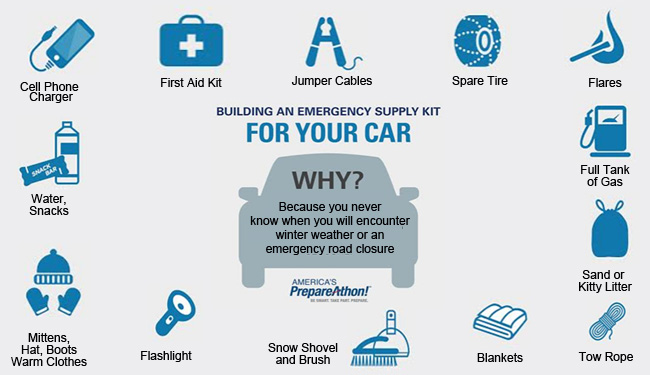
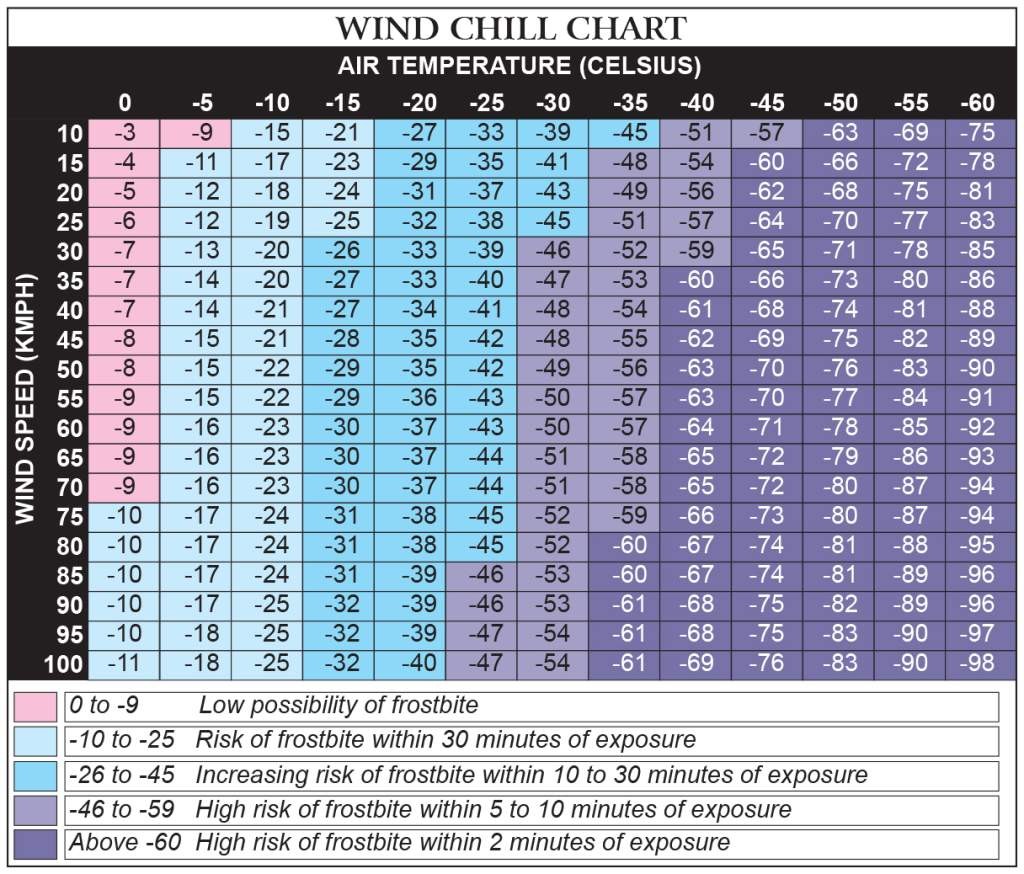


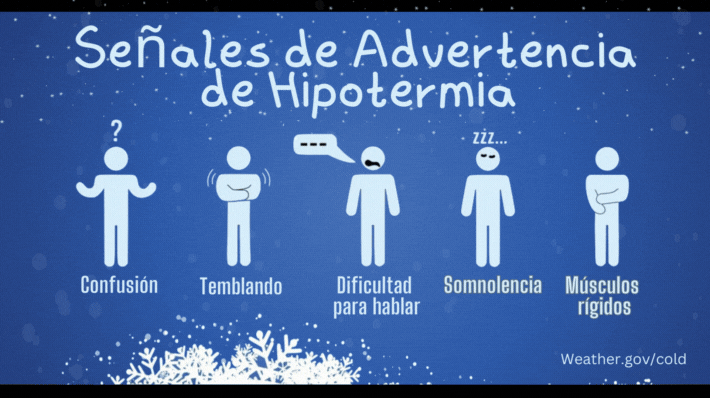

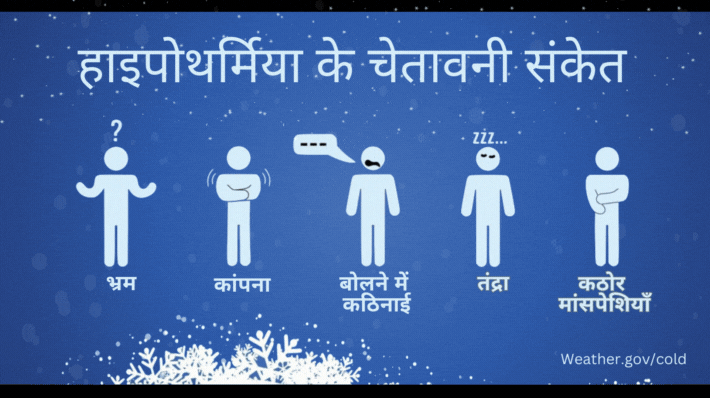


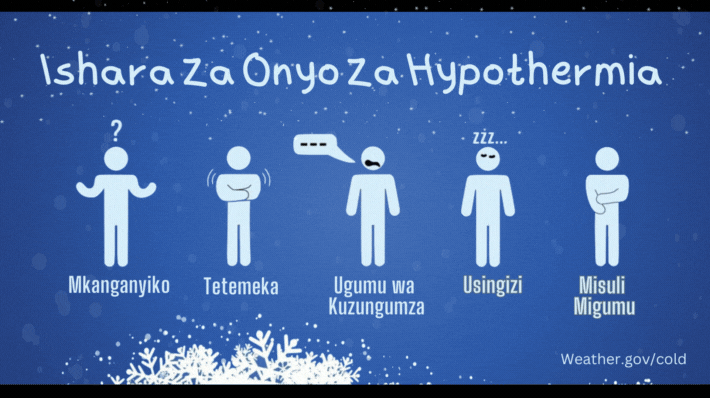

Here is some more information to help you think about the possible conditions in a winter storm. The combination of conditions and the duration matters.
Condition or Conditions | Situation | Impact for Vulnerable People | Plan Ahead |
Low Temperatures | Temperatures between freezing and 50° = risk of hypothermia. Freezing temperatures closer to 32° are less likely to cause frostbite. | Older adults, children and pregnant women may have a harder time regulating their temperature. People with mobility issues may have trouble seeking shelter. People who are unhoused or working outside are at risk. | Store water Wear hats Wear gloves Share warming supplies with those in need |
Very Low Temperatures | Frostbite is a concern outside, especially for long periods of time. | Older adults, children and pregnant women may have a harder time regulating their temperature. People with mobility issues may have trouble seeking shelter. People who are unhoused or working outside are at risk. Water and gas pipes can break when temperatures rise. | Bubble wrap on windows Drip faucets Get food and water Store extra water in bathtub, sink or containers Block draft Limit time outside Protect people, pets, pipes, plants Share supplies DON’T: use oven for heat or put generators inside |
Low or Very Low Temperatures + Rain or Freezing Rain or Snow | The risk of hypothermia increases a lot when wet. Rain can also ice over roads and materials. Snow can pack down and do the same. | In addition to above, rain is very hard on the unhoused population and people working outside when temperatures are very cold. Iced over roads may mean limited access to support. Iced over trees can break power lines. | See above + Alert vulnerable people & share supplies Limit time outside Snow tires Gas for generator Extra food and water Protect people, pets, pipes, plants DON’T: use oven for heat or put generators inside |
Low Temperatures and High Wind (and/or rain) | Wind takes heat from the body. High wind can destroy life-saving tents as well. | Destroyed tents combined with wind, freezing temperatures or rain can make it very hard for people stuck outside to protect themselves. | See above + Secure outside items. Check on unhoused community. New tents and tarps are needed. |
Any of the Above + No Power | Without power, phones can go dead, heating options are limited, and if a boil water notice is in place, other methods are needed. | Older adults may have trouble navigating their needs. People with generators may not be able to get gas to run them. People with electronic medical equipment. | Put perishables outside to keep cold. Run cord for electric heaters to generators placed outside only. Use fireplaces safely. Watch for broken pipes as temperatures rise.
|
Any of the Above + No Water | Broken water lines plus bad road conditions can limit water access. | Sanitary conditions and dehydration can affect people who are pregnant, small children, older adults, and people with certain conditions. | Gas lines may also be broken. If water runs low and roads are unpassable, advocate for outside support. |